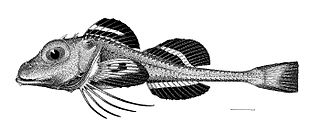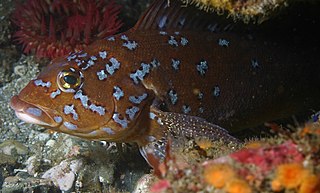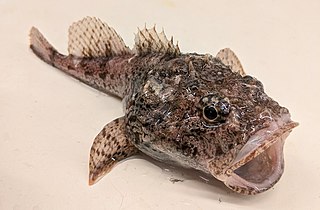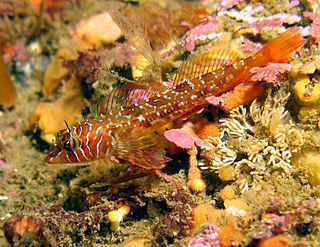
The Cyclopteridae are a family of marine fishes, commonly known as lumpsuckers or lumpfish, in the order Scorpaeniformes. They are found in the cold waters of the Arctic, North Atlantic, and North Pacific oceans. The greatest number of species are found in the North Pacific. The family name Cyclopteridae derives from the Greek words κύκλος (kyklos), meaning "circle", and πτέρυξ (pteryx), meaning "wing" or "fin", in reference to the circle-shaped pectoral fins of most of the fish in this family.
Zoarces is a genus of marine ray-finned fishes belonging to the family Zoarcidae, the eelpouts. It is the only genus in the subfamily Zoarcinae. These eelpouts are found in the northern Atlantic and northern Pacific Oceans.

Helicolenus is a genus of marine ray-finned fishes belonging to the family Scorpaenidae where they are classified within the subfamily Sebastinae, the rockfishes. The species in this genus are found in the Indian, Atlantic and Pacific oceans.
Phenacoscorpius, the no-lined scorpionfishes, is a genus of marine ray-finned fish belonging to the family Scorpaenidae, the scorpionfishes. They are native to the western Atlantic, Pacific and Indian oceans.
Bathylutichthys a genus of marine ray-finned fishes which is the only genus in the monotypic family Bathylutichthyidae, known as the Antarctic sculpins. These fishes are found in the Southern Ocean.
Notoliparis is a genus of marine ray-finned fish belonging to the family Liparidae, the snailfishes. These fishes are found in deep Oceanic trenches in the South Atlantic South Pacific and Southern Oceans.

Megalocottus is a small genus of marine ray-finned fishes belonging to the family Cottidae, the typical sculpins. These fishes are found in the western Pacific Ocean.
Cyclopteropsis is a genus of marine ray-finned fishes belonging to the family Cyclopteridae, the lumpfishes or lumpsuckers. These small lumpfishes are found in the North Pacific and Arctic Oceans.

Eumicrotremus is a genus of lumpfishes native to the northern oceans. The name for this genus comes from the Greek roots eu meaning "good", mikros meaning "small" or "little", and trema meaning "hole".

Ereunias is a monotypic genus of marine ray-finned fish belonging to the family Rhamphocottidae, the grunt sculpins. Its only species is Ereunias grallator which is a bathydemersal species found at depths of around 500 m (1,600 ft) in the northwestern Pacific Ocean off Japan. This species attains a maximum published total length of 30 cm (12 in). This species was first formally described in 1901 by the American ichthyologists David Starr Jordan and John Otterbein Snyder from Misaki, Sagami in Japan. Jordan and Snyder proposed the new genus Ereunias for the new species. The genus name is derived from ereunao, meaning "to explore" which may refer how it uses elongated pectoral-fin rays as feelers or "feet" to explore the substrate; suffixed with ias which is used in some Greek names for fishes. The specific name grallator is "stiltwalker" in Latin and is an allusion to the elongated pectoral fin rays. Along with the genus Marukawichthys this taxon was classified in the family Ereunidae but this was synonymised with the Rhamphocottidae in 2014.

Hexagrammos is a genus of marine ray-finned fishes belonging to the family Hexagrammidae, the greenlings. These fishes are found in the north Pacific Ocean.
Allocareproctus is a genus of marine ray-finned fishes belonging to the family Liparidae, the snailfishes. These fish are found in the northern Pacific Ocean.

The spinyhead sculpin is a species of marine ray-finned fish belonging to the family Psychrolutidae, the fatheads. This species is found in the northern Pacific Ocean. This species is the only species in the monospecific genus Dasycottus.

Gvozdarus is a genus of marine ray-finned fishes belonging to the family Nototheniidae, the notothens or cod icefishes. It is native to the Southern Ocean.

Panna is a genus of marine ray-finned fish belonging to the family Sciaenidae, the drums and croakers. These fishes are found in southern and southeast Asia.
Eumicrotremus barbatus, the papillose lumpsucker, is a species of marine ray-finned fish belonging to the family Cyclopteridae, the lumpfishes or lumpsuckers, found in the north Pacific Ocean. This species is characterized by the following unique apomorphies: teeth in the outer row at symphysis of premaxillae fuse with premaxillae, teeth at symphysis of dentary fuse among themselves and with dentary, forming the regular cutting edge; there are numerous barbs on the head and body; the bony plaques located in centers of connective tissue tubercles leaving the edges free. This species was originally classified in the monospecific genus Georgimarinus, but it is now regarded as a species within Eumicrotremus.

Eumicrotremus pacificus, sometimes known as the spotted lumpsucker or the balloon lumpfish, is a species of lumpfish native to the Northwest Pacific. It can be found in the Sea of Okhotsk, the Sea of Japan, the East China Sea, and the Pacific Ocean off Hokkaido and the Kuril Islands. It may be confused with the closely related Eumicrotremus orbis, which overlaps with E. pacificus in range, although E. pacificus is larger, reaching 20 cm (7.9 inches) TL. This fish is generally yellow to orange in color with small dark spots and its tubercles are usually smaller and less pronounced than E. orbis, giving it a less spiny appearance.
Eumicrotremus schmidti is a species of lumpfish native to the Northwest Pacific. It is a demersal fish known only from the northern Sea of Okhotsk, where it is found at a depth range of 20 to 143 m. Specimens of E. schmidti were once attributed to the related species E. andriashevi, which does not inhabit the Sea of Okhotsk. This species was first formally described in 1955 by the Soviet ichthyologists Georgii Ustinovich Lindberg and Marina Iosifovna Legeza with its type locality given as Penzhinskaya Bay in the Sea of Okhotsk in Russia. The identity of the person honoured in the specific name was not given by Lindberg and Legeza but it is likely to be Petr Yulievich Schmidt, a Russian ichthyologist.

Jordaniidae is a small family of marine ray-finned fishes belonging to the order Perciformes. These fishes are found in the eastern North Pacific Ocean.
Eumicrotremus fedorovi is a species of marine ray-finned fish belonging to the family Cyclopteridae, the lumpfishes or lumpsuckers. This species is found in the northwestern Pacific Ocean around the Kuril Islands. It is a demersal fish that occurs at a depth range of 115 to 370 m. This species was first formally described in 1991 by Sergey Anatolyevich Mandritsa with its type locality given as the Rikord Strait. The specific name honours the Russian zoologist Vladimir Vladimirovich Fedorov who studied the holotype and suggested that it represented a new species.










